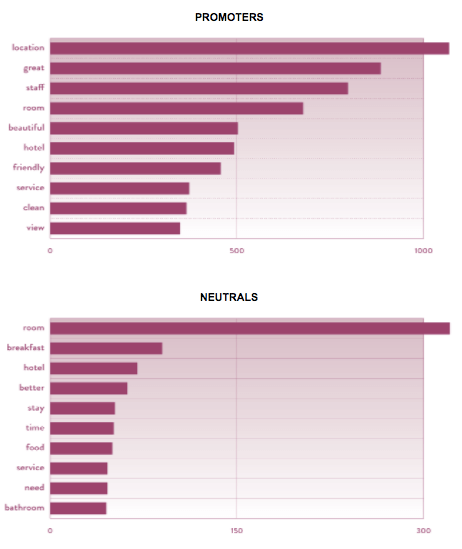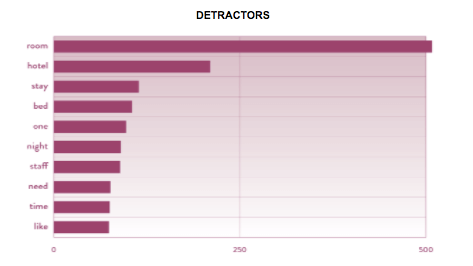Promoter, neutral or detractor?
RESEARCH AT CENDYN
What makes a guest a promoter, neutral, detractor? A text analysis of Net Promoter follow-up question responses
BACKGROUND:
In a previous research piece, we found that a hotel’s Net Promoter Score (NPS) has a h4 positive correlation with their TripAdvisor Rating (TAR). This finding, together with a logical argument that the level of guest advocacy for a hotel should influence the subsequent rating provided on TripAdvisor, provides a reasonable basis for hotel managers to adopt an instrumental strategy aimed at influencing their TAR through an understanding of the NPS.
This research piece utilizes text analyses of open-ended responses to NPS follow-up questions to build an understanding of the reasons why hotel guests recommend, stay passive, or recommend against.
1. DATA COLLECTION
Once a guest has answered the NPS question, s/he is prompted to provide contextual information through an open-ended follow-up question. Each respondent was categorized as either a promoter, neutral, or detractor based on their response to the NPS question. Based on this categorization, a specific follow-up question was subsequently asked. Promoters were asked:
“Thanks for your feedback, we’re glad to hear you’re happy! If you were recommending #{HOTEL_NAME} to a friend, what one reason would you give them?”
Neutrals were asked:
“If one aspect of your experience with #{HOTEL_NAME} could’ve been better, what would it be?”
Detractors were asked:
“What was missing or disappointing in your experience with #{HOTEL_NAME}?”
A total of n=5389 open-ended responses were collected. Specifically, promoters (n=3814), neutrals (n=823), and detractors (n=752)
2. ANALYSIS
2.1 Data Treatment
Several steps were involved in the analysis phase, beginning with the removal of ‘stopwords’ and ‘whitespace’. Stopwords can be defined in various ways, but simply they are common words or symbols in a language that cause confusion or ‘noise’ when attempting natural language modeling. Examples of stop words in English might be definite and indefinite articles (“the”, “a”), other functional words (“is”, “at”, “on”), symbols (“/”, “$”, “%,”, “&”), endings (“s”, “es”, “ies”), or punctuation marks, numbers, and so on. Similarly, ‘whitespace’ is simply unwanted spaces.
2.2 One-word Frequency
In the first key analysis, a one-word frequency count was utilized to quantify the most frequently used words when providing a reason for recommending for, staying passive, or recommending against a hotel. As it sounds, the analysis counted the number of times each individual word appeared in the open-ended responses. Words were then ranked by frequency and the top 10 words shortlisted. To display their relative importance, the top 10 words were placed in a ‘word cloud’, as depicted in figure 2.2.1. Note that when interpreting the word cloud, the size of the word represents its relative importance.
Figure 2.2.1:
Word Clouds of Top 10 One-words: Promoters, Neutrals, Detractors

Figure 2.2.2:
Bar Charts of Top 10 One-words: Promoters, Neutrals, DetractorsAnother method used to display the relative importance of single words is with a bar chart, where the words are plotted on the y-axis and the frequency on the x-axis, see figure 2.2.2 below.


With further examination of the 10 most frequently used words, we can identify key nouns and adjectives. In contextualizing nouns from the hotel perspective, we see that hotel “location” is most commonly used by promoters – not an easy one for a hotel manager to change – followed by “staff” and “room” rounding out the top 3. Note: arguably, “service” and “staff” could be considered the same concept. Also, guests appear to be referring to their experiences holistically when using the word “hotel”. Considering adjectives, promoters use words like “great”, “beautiful”, “friendly”, and “clean”. Considering neutrals, the top 3 nouns are clearly understood: “room”, “breakfast”, and “hotel”. However, adjectives are not so clear with “better” being the lone, and somewhat simplistic, describing word. Lastly, the top 3 nouns used by detractors are “room”, “hotel”, “stay”, with “bed” a close 4th. Adjectives seem to be rarely used by detractors in this context.
Comparing these single word frequencies across categories, we see that “staff” is a key reason why guests would recommend staying at a property, although it is not a common element of the guest experience that ‘could’ve been better’ or was ‘missing or disappointing’. In contrast, ‘room’ is the most common factor requiring improvement from the perspectives of both neutrals and detractors, and is the 3rd most common reason why a promoter would recommend. This suggests there are fundamental elements to the guest experience e.g. ‘room’ that properties must establish – known as ‘hygiene factors’ – before ‘nice to have’ factors, e.g. ‘staff’, can finalize a great experience.
The one-word frequency analysis provides some understanding of whether nouns were used in a positive or negative sense, by virtue of those words being used to answer the respective NPS follow-up questions – promoters: positive; neutrals: negative; detractors: negative. However, the one-word frequency does not directly link adjectives (positive, negative) with nouns. For this, two-word combination frequencies and keyword correlations were utilized.
2.3 Two-word Combination Frequency:
In the second analysis, a two-word combination count was utilized to quantify the most frequently used two-word combinations when recommending for, staying passive, or recommending against. Similar to the first analysis, this analysis counted the number of times each two-word combination appeared in the open-ended responses. Word combinations were then ranked by frequency and the top 5 words shortlisted. Figure 2.3.1 displays the relative importance of these two-word combinations in bar charts.
Figure 2.3.1:
Bar Charts of Top 5 Two-words: Promoters, Neutrals, Detractors


The results for neutrals and detractors were much more specific. The two-word combination frequency shows that when asked what could’ve been better, neutrals indicate overwhelmingly the ‘front desk’ is a common barrier to promoting a property. Similarly, ‘front desk’ was also the most common area for improvement from the detractor perspective – this implies check-ins and check-outs might be key. Also, aligned with the results from the one-word frequency analysis, the hotel room and related room aspects are highlighted in the two-word frequency results. Interestingly, eating at a property was found not as a pure hygiene factor or a high-end nice to have, but somewhere in the middle acting as a barrier preventing neutrals from promoting.
2.4 Keyword Correlations
In a final analysis, keyword correlations were calculated. Correlations quantify the strength and direction of associations between open-ended responses with certain keywords, where 1 is a perfect positive correlation, -1 is a perfect negative correlation, and 0 indicates no linear relationship. Tables 2.4.1, 2.4.2, and 2.4.3 below detail the top 2 notable correlations for each noun, in columns ‘first’ and ‘second’ respectively. Similar to the interpretation of the one-word frequency results, the two-word combination frequencies can be understood in terms of adjectives and nouns. Firstly, a location that is “great” appears as the most common reason guests recommend hotels – this is also consistent with the results from the one-word frequency analysis in section 2.2. Notably, “great location” and “location great” are charted separately but are measuring the same concept. Similarly, staff who are “friendly” or “great” could combine as the second most important element but might not be exactly representing the same concept – since friendliness might be one of several factors that combine to make staff “great”. This leaves “place stay” as the third most important factor, a more difficult factor to contextualize.
Table 2.4.1:
Keyword Correlations – Promoters

Table 2.4.2:
Keyword Correlations – Neutrals

Table 2.4.3:
Keyword Correlations – Detractors

The results of the correlations analysis provide some further insights. ‘Great location’ was reaffirmed as a key reason why guests would recommend. Friendliness and helpfulness of the staff were identified as qualities that contribute to a staff member being ‘great’. Room cleanliness and comfort was identified across all NPS categories, emphasizing the room quality theme of guest experience. Specifically, room cleanliness and comfort – especially of the bed for detractors.
SUMMARY:
The findings in this article provide hotel managers with an understanding of the main reasons hotel guests recommend, stay passive, or recommend against staying at a property. Importantly, this understanding is based on what guests have explicitly stated, known as ‘stated importance’. Another common method is ‘derived importance’ where the importance of factors associated with hotel guests making recommendations is ‘derived’ or drawn from statistical relationships between variables – derived importance will be used in a future research series.
This research finds hotel guests state they would recommend a hotel(s) to someone they care about primarily because of the location and staff. More specifically, a ‘great location’ and ‘friendly staff’ or ‘great’ staff’. A noteworthy third reason is the room, particularly ‘spacious rooms’ and ‘clean rooms’. While location will be difficult for a hotel manager to affect, staff and rooms are certainly areas an instrumental strategy could impact.
However, also discovered by this research are several ‘hygiene factors’ – those elements of the guest experience that first need to be met, to prevent dissatisfaction, before increased satisfaction can be promoted. Room quality was highlighted throughout the results as a key hygiene factor. Specifically, room cleanliness and comfort, such as room cleaned and free of garbage, room temperature appropriate to a specific guest, bed, and bedding clean and comfortable. A likely hygiene factor was hotel operations. This included guest front desk interactions, professionalism, and timeliness. Notably, it appears the hotel operations factor can be impacted by elements of both staff and operational processes.
Lastly, and perhaps one of the most interesting findings, was the impact of hotel dining experience. Among neutrals, the availability of dining options, and the delivery of those options can prevent guests from becoming promoters. The dining factor does not appear to be a hygiene factor, in so far as poor dining options are unlikely to create detractors, rather a middle-ground factor that might be enough to drive promotion if hygiene factors are met.
While providing dining options is a double-edged sword, overall, a well-located property with good rooms, systems, and staff, is positioned to perform.



